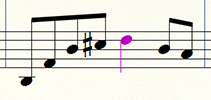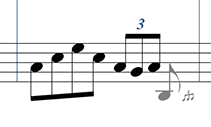Making changes - editing with Simple Entry
Editing your entered music with the Simple Entry tool.
Whether you make a mistake when entering notes, or you change your mind about a passage, Simple Entry is the fastest, most efficient way to change music that has already been entered. With Simple Entry, you can change existing pitches or durations as well as add notes above or below a written note to create chords.
By the end of this lesson, you will know how to:
- Edit using the Simple Entry palette
- Edit using your computer keyboard
To begin at this point, open tutorial document Tutorial 2a.MUSX.
Editing using the Simple Entry palette
One option is to use the tools on the Simple Entry palette to make changes.
- Select the Simple Entry tool
 .
.
- Click the Eraser tool
 in the Simple Entry palette. Notice an eraser appears next to your mouse cursor.
in the Simple Entry palette. Notice an eraser appears next to your mouse cursor.
- Click the first note in measure 1, top staff. The dotted quarter note disappears. Subsequent notes shift to the left.


Note: At this point, do not choose any other tools or click another measure. If you do, Finale will automatically fill this measure with rests and you will need to undo (press CTRL+Z) until the automatic rests disappear to resume.
- Now, let's insert a quarter note. Click the Quarter Note tool
 and click the F space just to the left of the eighth note.
and click the F space just to the left of the eighth note.


- Immediately after you enter a note, you can click it again and drag vertically to change the pitch. Let's do that now. Click the quarter note F you just entered and drag it up one step to G.
Watch video "Dragging to adjust the pitch."
- You can't simply click the following eighth note and change its pitch, because it will also change to a quarter note. To click and drag any pitch at any time without changing its duration, hold down the CTRL key, then click and drag.
Watch video "Dragging to adjust the pitch without changing the duration."
- Click the Dot tool
 so your cursor looks like a dotted quarter note and then click the first G quarter note to change it back to a dotted quarter. Now we should be back where we started. Let's continue arranging our song by replacing the half note in the left hand piano staff with two quarters.
so your cursor looks like a dotted quarter note and then click the first G quarter note to change it back to a dotted quarter. Now we should be back where we started. Let's continue arranging our song by replacing the half note in the left hand piano staff with two quarters.
- Double-click the Quarter Note
 in the Simple Entry palette.
in the Simple Entry palette.
- Click on the half note B in the bottom piano staff to turn it into a quarter note.
- Click on the G space to add a quarter note G on beat 4.
Watch video "Replacing a half note with two quarter notes."
Note: If you increase a note's duration you'll need empty space in the measure–Finale prevents you from overfilling a measure. If you are unable to lengthen a note or add new notes to a measure, try deleting some other notes first or change one to a shorter duration.
Editing with Simple Entry and your computer keyboard
Alternatively, use your computer keyboard to make changes. As was just pointed out, you can select any individual note in the score by holding down your CTRL key and clicking on the note. Once you’ve selected a note, there are many keyboard commands you can use to edit it.
-
CTRL+click the F in the bottom staff, measure 2. The note is purple, indicating it is now active, and can be edited. Let's use our keyboard to make some common changes, starting with the duration.

Note: If you make a mistake, you can always press CTRL+Z to Undo.
-
ALT + 1-8 changes the duration. Hold down ALT and type 4 on your keypad to turn it into an eighth note. Then, press ALT+5 to change it back to a quarter. At this point, you could choose from many editing keystrokes. For example, you could press T to add and remove a tie, or ALT+G to convert the note to a grace note. All these keystrokes are listed under the Simple menu > Simple Edit Commands.
- The arrow keys can be used to navigate. Press RIGHT ARROW to select the D. Press CTRL+UP ARROW to move selection up a staff, then CTRL+DOWN ARROW to move it back. Now, let's change some pitches.
- With the D eighth note selected, type C, B. Simply type the letter name to change the pitch of a selected note. (Notice the caret appears. Typing the note letter can also be used for entry). Now, let's change them back.
- Press LEFT ARROW three times (so the C is selected) and type D, C.
Watch video "Using Simple Entry keyboard shortcuts."
To learn all of Simple Entry’s powerful editing functions, open tutorial document EntryExercises.MUSX.
Tip: Using your MIDI Keyboard to specify the pitch in Simple Entry: With the caret active, simply play the desired note or chord to add it to the score. Use the Simple Entry palette or your computer’s keypad to change to a new duration.
Adding triplets
In Finale, tuplets are any irregular grouping, including triplets, quintuplets, and so on. HyperScribe users may choose to play them into the score while recording, however you can also use Simple Entry to define your tuplet and enter it quickly.
When looking at the tools on your screen, you may notice two that look the same: the Tuplet tool on the Main Tool palette and the Simple Entry Tuplet tool. Although they look the same, these tools have very different functions. For this section, we’ll use the Tuplet tool found in the Simple Entry palette to enter a triplet.
- Select the Eraser tool
 from the Simple Entry palette.
from the Simple Entry palette.
- Erase the quarter notes on beats 3 and 4 in measure 4, bottom staff.
- Select both the Eighth note tool
 and the Tuplet tool
and the Tuplet tool  from the Simple Entry palette.
from the Simple Entry palette.
- Click-in the triplet on beat three as shown below. With the first click, Finale creates the triplet bracket with two rests. For the second two notes, click to overwrite the rests.

Watch video "Entering triplets with the mouse."
Entering triplets with the computer keyboard
The fastest way to enter exactly the kind of tuplet you want is with the computer keyboard.
- Double click the Eighth Note tool
 to deselect the tuplet. (The last note of the triplet should still be selected)
to deselect the tuplet. (The last note of the triplet should still be selected)
- Press ENTER to activate the Simple Entry caret.
- Type the letter C to enter an eighth note.
- Type the + (plus sign) to raise the pitch to a C#.
- Type the number 9 (either one) and the triplet bracket and two eighth rests appear.
- Now, simply type the pitch letters, using the + key for the accidental, to replace the rests with notes. Complete the triplet as shown. (For the last C sharp, Finale is smart enough to automatically inherit the accidental from the first note of the triplet, without showing it).

For the last beat of a measure, it's particularly important to specify you are entering a tuplet prior to entering the notes (as shown in both cases here). If, for example, you try to enter the notes first and then change them to a triplet, you may notice there is not enough room in the measure.
Note: You can quickly define quintuplets, sextuplets or any other value with Simple Entry. Enter the first note of the tuplet, then press ALT+9 to bring up the Simple Entry Tuplet Definition box. Specify the kind of tuplet you wish to enter and press OK. Finale inserts the correct bracket and enters the appropriate number of rests so you can enter your notes.
Watch video "Entering triplets with the computer keyboard."











 Previous
Previous

